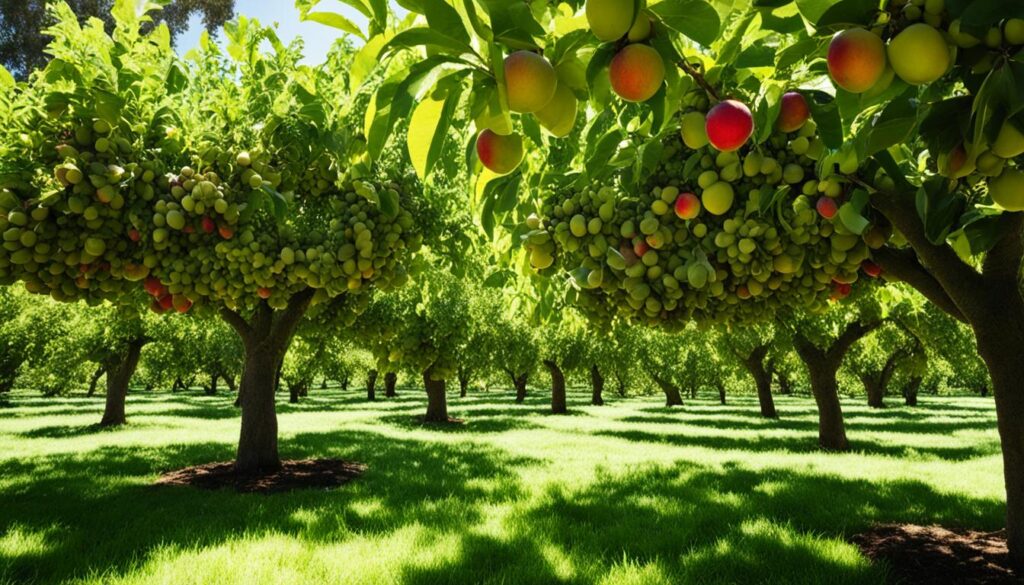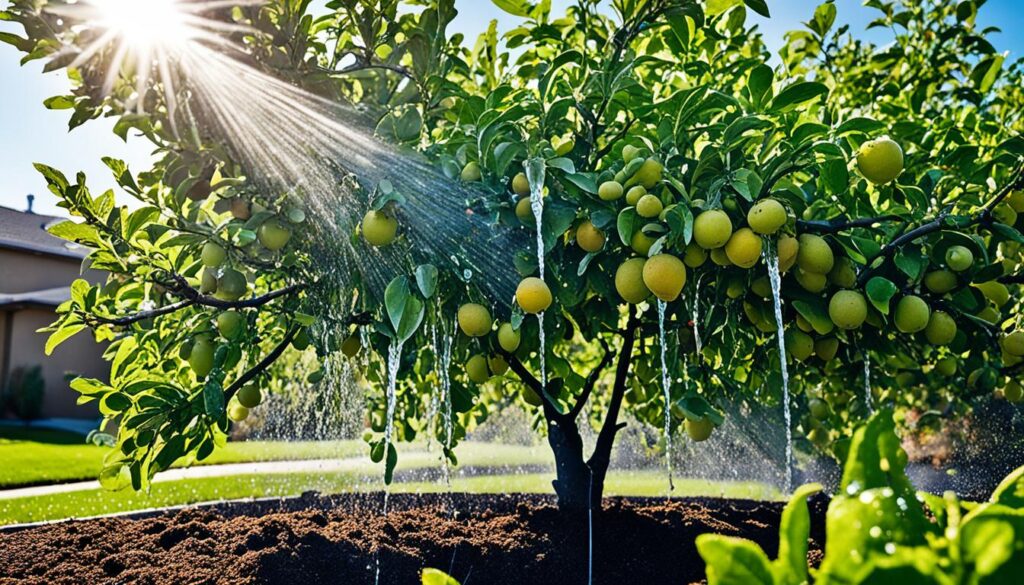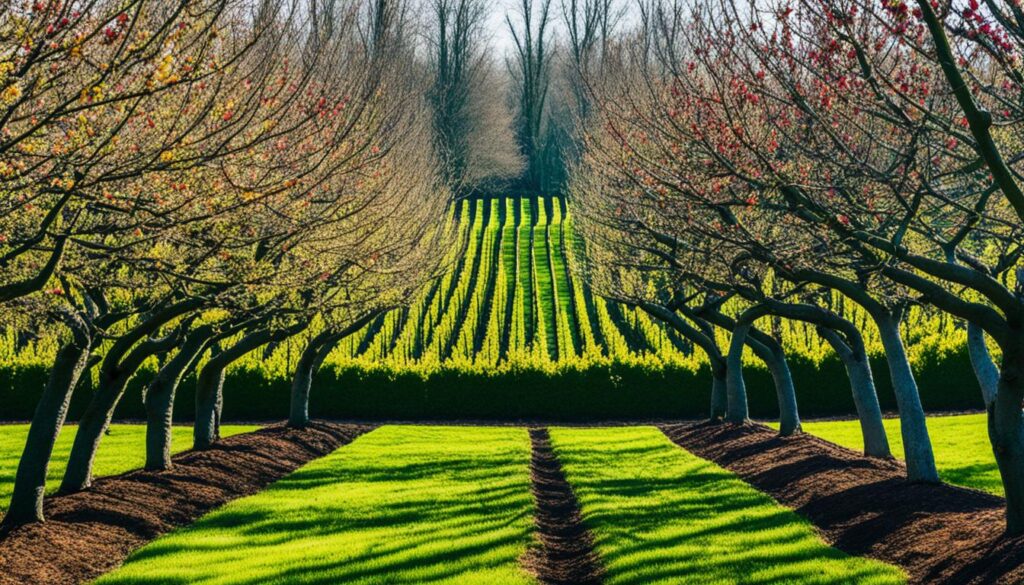Are you ready to make your fruit trees give more fruit every year? This guide will show you how to get the most from your trees. We’ll cover pruning, soil care, and keeping pests away. Get ready to turn your garden into a place full of tasty, fresh fruits.
Fruit trees make any garden exciting, giving you tasty food and a link to nature. But to get the most from them, you need a good plan. This article will give you tips and advice for a great harvest from your trees.
If you love fruit trees or are just starting, you’ll find lots of useful info here. We’ll talk about pruning, fighting pests and diseases, feeding the soil, and picking your fruits at the best time. Get ready to see how these expert tips can change your garden.
The Importance of Sunlight and Airflow
Healthy fruit tree growth needs lots of sunlight and good air flow. Trees should get at least 6-8 hours of direct sunlight each day. This is key for their health.
Pruning trees helps keep their canopy open. This lets more light in and air move through. It also lowers disease risk. Proper fruit tree positioning and fruit tree canopy management are key for more fruit.
Tree Positioning for Optimal Sunlight
When planting fruit trees, think about their sunlight needs. Pick a spot that gets 6-8 hours of direct sunlight daily. This helps trees make food and grow well.
Avoid planting in shady spots or near buildings that block sunlight. These can cast shadows on trees all day.
Canopy Management for Better Air Circulation
Keeping a tree’s canopy open is vital for fruit tree air circulation. Prune trees often to remove branches that are too close or growing inward. This lets air flow better through the tree.
Better air flow means less disease and healthier trees. This leads to more fruit.

Focus on fruit tree sunlight requirements and fruit tree canopy management. This creates the best conditions for your fruit trees. It leads to lots of fruit and a healthy orchard.
Improving Soil Quality for Healthy Growth
The quality of the fruit tree soil is key to your orchard’s health and productivity. Testing your soil often gives you important info on nutrients, pH, and organic matter. With this info, you can fix the soil to make your fruit trees grow better.
Conducting Soil Tests
Testing your soil first helps you understand what your trees need. It shows you if there are any missing nutrients or imbalances. This lets you choose the right soil amendments to help your trees grow well.
Amending Soil with Organic Matter
Adding organic matter to your fruit tree soil is a great way to make it healthier. You can use compost, aged manure, or other rich materials. This stuff gives your trees the nutrients they need and makes the soil better at holding water and supporting life.
| Soil Amendment | Benefits |
|---|---|
| Compost | – Enhances soil fertility and structure – Improves water-holding capacity – Supports beneficial soil microorganisms |
| Aged Manure | – Supplies a wide range of essential nutrients – Improves soil texture and aeration – Increases organic matter content |
| Cover Crops / Green Manure | – Fixes atmospheric nitrogen into the soil – Prevents erosion and nutrient leaching – Adds organic matter when tilled into the soil |
By testing your fruit tree soil often and adding organic matter, you can make it perfect for your trees. This leads to more fruit and healthier trees.

Proper Watering Techniques for Fruit Trees
Watering your fruit trees right is key for their health and fruit production. Young trees need water for 2-3 months to grow strong roots. In a community orchard with clay soil, trees get watered twice a week with 15 gallons each time. Trees in sandy soil need more water because it doesn’t hold moisture well.
Water should go around the tree’s drip line to reach the roots. Drip irrigation works great for watering trees, with emitters a foot apart in sandy soil. In cold areas, trees don’t need water in winter. But in warmer places, evergreen trees like citrus might need water even in winter.
Check the soil moisture near the tree’s dripline after watering. Dig 6-12 inches deep to see if your watering is working. Proper watering means more fruit, as Robert Kourick says more water means more fruit.

Advantages of Drip Irrigation
- Higher water efficiency due to reduced evaporation compared to sprinklers
- Flexibility in running irrigation at any time of day regardless of wind effects
- Ease in calculating the amount of water delivered to each tree
Disadvantages of Drip Irrigation
- Emitter clogging
- Interference by external factors like chickens moving the tubes
- Increased effort required to adjust drip systems as trees grow
Drip irrigation is a big win for fruit trees worldwide. It’s shown to boost fruit production. To get the most out of drip irrigation, aim to wet 60 percent of the soil under the tree. Place emitters as wide as the tree’s canopy to spread the water evenly.
Seasonal Care: A Year-Round Commitment
Looking after your fruit trees all year is key to getting the most from them. From spring to fall and winter, taking care of your trees is vital.
Spring Care: Preparing for the Growing Season
When spring comes, check your trees for pests or diseases. Then, prune them to remove dead branches. This helps them grow strong. Also, give them a fruit tree fertilizer to help them grow well.
Summer Maintenance: Mid-Season Tree Care
In summer, make sure your trees get enough water, especially in dry places like Seattle. Check the soil often and water when needed. This keeps your trees healthy and helps the fruit grow big and juicy. Also, take some fruit off to let the rest grow better.
Fall and Winter Practices: Post-Harvest Care
After picking the fruit, get your trees ready for the cold months. Clean up leaves and debris around the trees to stop pests and diseases. A little pruning in late fall or early winter keeps the tree’s shape and prepares it for next year’s harvest.

By doing these seasonal care tasks all year, your fruit trees will stay healthy and give you lots of fruit every season.
Dormant Pruning: A Fruitful Practice
Pruning your fruit trees in late fall to early spring is key for their health and fruit production. This time lets you see the tree’s structure well, lowers disease spread, and helps growth in the next season. Fruit tree dormant pruning boosts new fruiting wood, makes fruit bigger and better, and fights tree diseases and pests. All these help increase your fruit production.
Benefits of Dormant Pruning
- Pruned fruit trees will be bigger than unpruned trees after a single growing season.
- Pruning back to buds aimed in the desired direction helps trees grow into a spreading shape.
- Dormant pruning is considered the most invigorating as it allows carbohydrates stored in roots and wood during winter to be allocated to fewer growing points.
- Pruning in early spring stimulates growth below the cuts and removes actively growing leaves, while pruning from mid-spring through summer reduces tree vigor to some extent.
Impact on Fruit Production
Proper dormant pruning boosts your fruit tree’s productivity. It removes growth that competes and focuses the tree’s energy on the branches that matter. This can:
- Increase fruit size and quality
- Improve disease and pest management
- Promote the development of new fruiting wood
Also, dormant pruning shapes the tree’s structure. This ensures it gets enough sunlight and air, vital for healthy fruit production.

Adding dormant pruning to your care routine is a smart move for boosting your fruit yields. It’s a fruitful practice you shouldn’t skip.
Fruit Tree Harvesting Tips: Maximizing Yield
Harvesting your fruit trees right is key to getting a lot of fruit. Picking at the best time, using the right tools, and storing well can make a big difference. Here are some tips to help you get the most from your trees.
Timing Your Harvest for Peak Ripeness
Harvesting at the right time is crucial. Watch your trees closely for color changes and softening fruit. Taste the fruit to make sure it’s sweet and flavorful. Knowing when to pick each type of fruit can make your harvest better.
Utilizing Proper Harvesting Tools
The right tools can improve your harvest. Get good pruning shears or fruit pickers to pick gently. Don’t use sharp things that could hurt the tree or the fruit.
Implementing Effective Storage Techniques
After picking, store your fruit right. Handle it carefully to avoid damage. Use storage containers or crates made for fruit tree storage. This keeps your fruit fresh longer and lets you enjoy it all year.
Follow these tips for better fruit tree harvesting. Get the most from your trees by picking at the best time, using the right tools, and storing well. This way, you’ll have plenty of fresh, tasty fruit.
| Harvesting Tip | Description |
|---|---|
| Timing for Peak Ripeness | Monitor visual cues, conduct taste tests, and harvest at the optimal time for each fruit variety |
| Proper Harvesting Tools | Use pruning shears or fruit pickers to gently remove fruit without damaging the trees |
| Effective Storage Techniques | Carefully handle the fruit, store in a cool, dry place, and use storage containers or crates designed for fruit tree storage |
Pest and Disease Management for Bountiful Harvests
Keeping your fruit trees healthy is key for lots of fruit. Pests and diseases can harm your trees and lower the quality of your fruit. Using fruit tree pest control and disease management is vital to protect your trees.
Integrated Pest Management (IPM) is a great way to fight pests and diseases. It uses many methods like culture, physical, chemical, and biological to keep pests down. This method helps keep your trees healthy without using too many chemicals.
- Physical methods, like covering plants, can keep insects and birds away.
- Using organic sprays early can stop pests before they cause damage.
- Checking your trees often for pests or diseases and acting fast is key to keeping them healthy.
By using these methods, your fruit trees will stay strong and give you lots of fruit every year.
| Pest/Disease | Symptoms | Management Strategies |
|---|---|---|
| Aphids | Curled, distorted leaves; honeydew secretions | Encourage natural predators, use insecticidal soap |
| Powdery Mildew | White, powdery growth on leaves and fruit | Apply baking soda solution, promote air circulation |
| Fire Blight | Blackened, wilted leaves and branches | Prune affected areas, apply copper-based fungicides |
By watching closely and using these fruit tree pest control and fruit tree disease management methods, your fruit trees will stay healthy. This means you’ll get bountiful harvests every year.
Organic Fruit Tree Care: A Sustainable Approach
For those looking for a greener way to care for fruit trees, natural pest control and composting are great options. These methods help keep your trees healthy and productive. They also reduce harm to the environment.
Natural Pest Control Methods
Organic gardeners use helpful insects to fight pests. Ladybugs, lacewings, and praying mantises can keep aphids and mites away. Natural sprays like neem oil or garlic can also keep pests off your trees.
Composting and Mulching
Composting is key to caring for fruit trees organically. Adding compost to the soil boosts nutrients, improves soil health, and helps trees grow strong. Mulching with wood chips or leaves keeps weeds down, saves water, and protects roots from extreme temperatures.
Using natural pest control and composting makes your fruit trees thrive. This approach creates a healthy, organic fruit tree garden that gives you lots of fruit every year.
When to Harvest: Timing for Peak Flavor
Knowing when to pick your fruit trees is key for the best flavor and quality. Look for signs like color, texture, and smell to know when to pick. This way, you get the most taste and nutrition from your fruit, making harvests more rewarding.
Color change is a big clue for fruit ripeness. Fruits turn from green to yellow or orange as they get ready. Also, if the fruit comes off the tree easily, it’s likely ripe.
Smell is another way to tell when to pick. A fruity smell means the fruit is at its best flavor. The taste also changes, becoming sweeter, which shows it’s ripe.
By watching for these signs, you can pick your fruit at the best time. This makes sure your apples, pears, or other fruits taste great. For more tips on tree planting and keeping fruit trees healthy, check out our resources.



